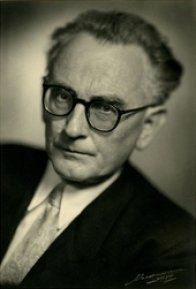Georg Trexler
Georg Trexler was born on 9 February 1903 in Pirna (Germany). His father worked as a gaffer and had a small own business. In the early years of Georg Trexler the family moved to Plauen where he graduated from school in 1921. His father wanted his son to take over the family business in the future and so Georg Trexler at first made a bank apprenticeship in Plauen and Dresden. In 1924 he moved to Leipzig to study economics and law. But after two years Georg Trexler quit these fields of study and switched to music. He then studied at the faculty for sacred music and his teachers were Fritz Reuter (composition), Karl Straube (organ), Carl Adolf Martienssen (piano) and Max Hochkofler (score reading/conducting).
Already during his study years Georg Trexler worked as the cantor of the Liebfrauenkirche in Leipzig-Lindenau. In 1929 - immediately after his studies - he was appointed cantor and choir master at the St. Trinitatiskirche in Leipzig. In 1940 Georg Trexler was drafted for military service in World War II and served as a typist. He was wounded twice during the war years and finally got into French war captivity in April 1945, but was released already in August 1945. Georg Trexler went back to Leipzig and continued his position as cantor at St. Trinitatis. He also became lecturer for organ, liturgics, history of sacred music and score reading at the University of Music and Theatre Leipzig in 1946, and was appointed professor two years later. Georg Trexler fulfilled both positions - as cantor of St. Trinitatis and as professor at the university - until his retirement in 1969. In his last years he focused on composing. Georg Trexler died on 15 December 1979 in Leipzig (Germany).
Georg Trexler was one of the most important German composers of sacred music in the 20th century. His work catalogue contains several masses, cantatas, passions, litanies, hymns, motets, choral and organ compositions. His most famous works are surely his cantata "Metanoeite, for baritone, mixed choir and orchestra" and his "German Te Deum, for mixed choir and organ". But Georg Trexler also composed secular music: several compositions for orchestra, concertos for piano, organ, oboe and cello and chamber music.
In my possession is the autograph manuscript of the violin solo part of the "Concertino for violin and orchestra" (1939) by Georg Trexler. According to the solo part the Concertino is written in one movement with the tempo markings "Allegro - Molto tranquillo - Vivo, non presto - Allegro".
This manuscript is extremely interesting because there is no Concertino for violin and orchestra in the work catalogue of Georg Trexler! There are only two small compositions for violin and chamber orchestra from 1943, but they differ to the solo part in my possession. This means that the Concertino is a previously unknown work by Georg Trexler and unfortunately the orchestral parts are still missing. This fate happened to some of the early compositions by Georg Trexler which got lost in the trials of war-time.
